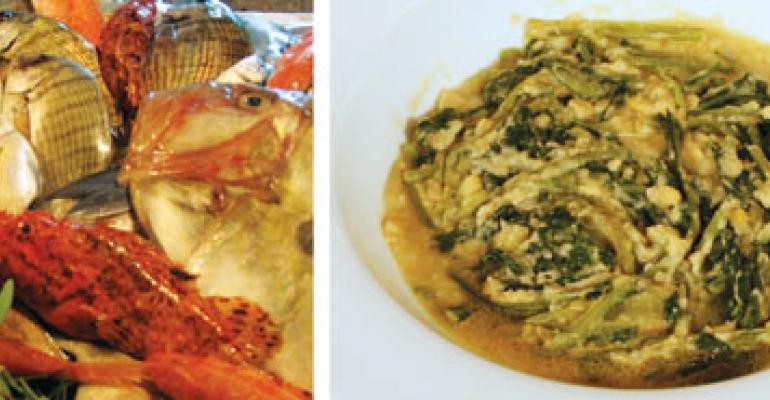Southern Italian food in the United States is both the beneficiary and victim of generalization. So-called “red-sauce Italian” is arguably Americans’ favorite “ethnic” cuisine. But as diners seek greater authenticity, they, and the restaurateurs serving them, are discovering the variety of cuisines in southern Italy.
One of Italy’s southernmost regions, sunny but windswept Puglia, is not only the heel and ankle of the great Italian boot—jutting out into the Adriatic Sea, it is not protected by the Alps from chilly European winds—but also its breadbasket, wine cask and olive oil jug.
Of all of Italy’s 20 regions, Puglia produces the most wheat and olive oil, and by some estimates 70 percent of all of the wine in the country, making it the main producer of three pillars of Mediterranean cuisine.
The region has pasta and red sauce, to be sure, although the pasta usually is circular orecchiette or cavatelli, like chunky uneven macaroni, rather than spaghetti. But its abundant seafood, Old-World beans such as fava and chickpeas, and bitter greens are at the core of its everyday fare.
An important daily staple is fave e cicoria. Although the name technically means fava beans and chicory, any bitter green will do—from escarole to broccoli raab.
Thomas Verdillo, chef-owner of 36-year-old Tommaso restaurant in Brooklyn, N.Y., recently returned from an exploratory trip to Puglia with the Grupo Ristoratori Italiani—an organization of Italian-American restaurateurs who visit a different Italian region each year—and served his own version of the dish.
Typically for fave e cicoria, fava beans are puréed, poured over cooked greens and drizzled with olive oil. But Verdillo used large gigante beans and decided they’d look better if he didn’t purée them. So he kept them whole and served them in a sort of stew with dandelion greens, a common southern Italian vegetable.
Anna Buonosante, who represents Puglia in a new web-based show called Cooking with Nonna, which can be seen at
Other typical Pugliese dishes Buonosante prepares are eggplant and artichokes, each stuffed with breadcrumbs, eggs, cheese, parsley, garlic and mint, covered with marinara sauce and baked, sometimes over potatoes that absorb the sauce and vegetable juice. Or it can be served with spaghetti, Buonosante says.
Puglia is part of what the Romans called Magna Graecia, or “greater Greece.” Greeks began crossing the Adriatic and settling there in the Eight Century B.C. To this day the region has a large Greek Orthodox population, and at Bari’s cathedral, Basilica di San Nicola, both Roman Catholic and Greek Orthodox masses are held—Catholic on the ground floor, Orthodox in the basement.
Greek influence can be seen in the food, too, both in Pugliese’s affinity for bitter greens and in the simplicity in preparation of fresh seafood. Cooking with Nonna producer Vito Rago, from the Publiese town of Mola di Bari, praises what locals call the pesce di scoglio, or fish of the rocks, which often are brightly colored and more intensely flavored than fish caught farther out into the Adriatic Sea or the Mediterranean.
“You can smell the algae of the sea when you eat it,” he says, adding that mussels and octopus also are abundant in coastal areas.
At restaurants like Da Tuccino in the Pugliese seaside town of Polignano a Mare, diners suck sea urchin live from the shells and sop up whatever is left in the shells with bread. They eat raw red mullet, scorpion fish and swordfish, as well as batter-fried mullet and other super-fresh fish seasoned simply with lemon.
Hard durum wheat grown in the region’s high Murgia plain—also home to black pigs that are grilled and cooked with wild bitter greens and radicchio—is used to make much of Italy’s pasta, as well as crusty but moist bread that is shipped daily all over Italy.
You can also see “Pugliese bread” accompanying dishes from other parts of Italy, such as the ribollita—a Tuscan bean soup—that was served at Rioja in Denver last winter. Burrata—balloons of cow’s milk mozzarella stuffed with unformed mozzarella shreds and heavy cream—also comes from Puglia.
Among wine grapes that flourish there is Primitivo, particularly on the Ionian Sea, the arch in Italy’s foot. So-called not because it’s primitive, but because it ripens early, Primitivo is a genetic twin of Zinfandel. Other popular grapes are the Nero Amaro and Nero di Troia.
Pugliese wine traditionally is sold to other regions for further processing or it’s meant to be sold cheap and drunk fresh—in fact, machines resembling gas pumps are used to dispense it to customers for as little as $1 per liter. But with recent investments in the region by major wine producers up north, most notably Tuscany-based Antinori, the wine is starting to receive more serious attention.
New York restaurateur Nicola Marzovilla, a native of Bari, says Pugliese items such as burrata and grilled baby octopus have been staples at his restaurant, i Trulli—named for the conical shelters that are unique to one section of Puglia—since it opened 15 years ago. Another Pugliese item that is popular in his restaurant is baby calzone filled with mozzarella and fresh tomato, called panzarotti.
“It’s very typical, not necessarily as part of a meal, but as a snack,” he says.
Another popular item at i Trulli, from Lecce, is ceci e tria, which are flat ribbons of pasta, some of which are fried. The rest are boiled and then all of it is tossed with ceci, or chickpeas, and fresh tomato.
Also popular is burnt-flour pasta, from the Murgia. “The old bakers used to sweep out the ovens at the end of the night, and they’d use that to make pasta,” Marzovilla explains.
Almond is the favored nut of the region, and almond cookies are a common dessert. So are poached fruits served with ricotta and vin cotto—cooked grape must similar to what is made into balsamic vinegar farther north. In Puglia itself, in the southernmost province of Lecce, producers have started to make the region’s vin cotto into vinegar as well.— [email protected]




